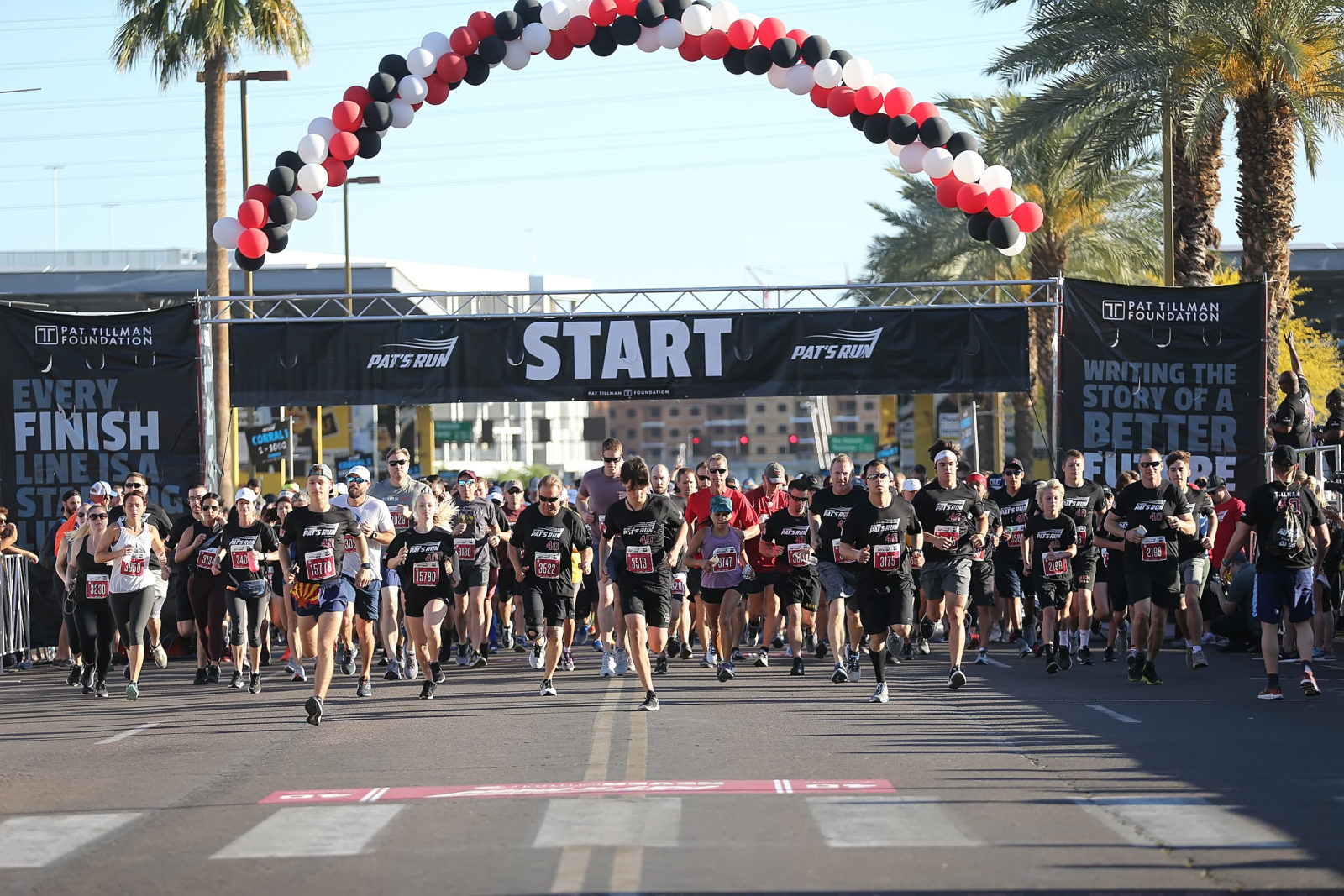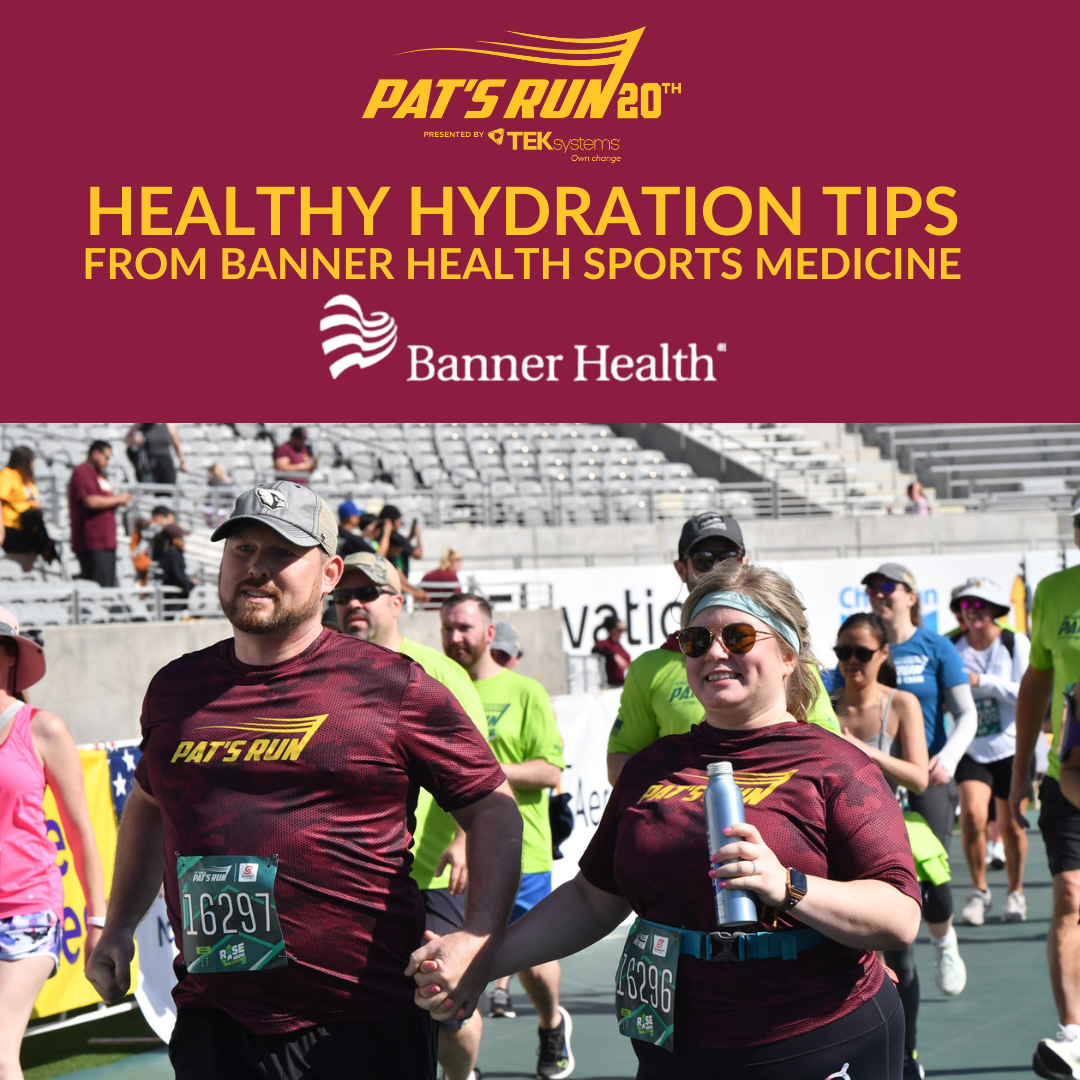Couch to Pat’s Run Training Program
By Dan Casey, MD, Amy Jo Overlin, MD, Steven M. Erickson, MD, Banner Sports Medicine
Welcome to the 2021 Pat Tillman Run Medical Blog. With the 17th Annual Pat’s Run being held virtually and all of us having a change in our normal exercise routine related to COVID-19, we want to provide some simple guidance for our runners. These posts will range from starting a training program to injury prevention, treatment and nutrition. We hope you enjoy these short educational snippets and we thank each and every one of you for your continued support of Pat’s Run, the Tillman Scholars and to your commitment in keeping Pat Tillman’s legacy alive year after year and for generations to come.
Most people have heard of couch to 5K programs, but 5 kilometers is about 3.1 miles. Since our race is 4.2 miles we will be upping the distance, but following a similar progressive program. The following program should be completed over 9 weeks to minimize injury and maximize training. Arriving late to the training program? Don’t worry; simply walk the remaining mileage. This is all about helping you develop a regular exercise routine that lasts past Pat’s Run and, most importantly, ensure you’re having fun.
So how does one track their mileage? There are multiple ways to address this:
- Use free phone apps to track your mileage; there are simply too many options to list, a few include Strava, Run Tracker, and RunKeeper. Most have a free version, so don’t feel pressured to upgrade to a different version.
- Use a treadmill
- If available, run at a local school track. Each lap around the track equals approximately ¼ of a mile. Therefore four laps around a school track equals 1 mile.
This is an adapted run protocol similar to most Couch to 5K running programs designed to help beginner runners get ready for the big day. If you have any known health conditions, it is strongly recommended to speak with your physician prior to beginning any new exercise program. Other reasons to see your physician would be chest pain, excessive shortness of breath, dizziness, you feel like your heart is beating funny or irregular or you just don’t feel right while trying to begin this new exercise program. You should also see your physician if you have had COVID19 as you may be at increased risk of myocarditis and may require further screening to prevent problems. In addition, one should always wear comfortable well-fitting shoes and clothes. Lastly, focus your training program on time, not distance, as running too fast can tire you out more quickly, make you feel discouraged or prevent you from completing your race. Good luck racers and HAVE FUN!
General Rules:
1. Run/walk days should alternate with rest days where no running or light cross-training is done. Some of the best cross-training for running can include swimming, cycling, elliptical or yoga!
2. All workouts should begin with a brisk walk for at least 5 minutes to help get the blood flowing and warm up the muscles.
3. This program is based off the participant running at a 10 minute/mile pace or 6 miles/hour. If that’s too fast for you, that’s okay—walk part of the course or extend your total jogging time. The goal is truly to have fun and complete it safely while helping you get in better physical shape. One size never fits all. Mold the program to work for YOU!
Week 1:
- 5 min warm up
- Alternate Jogging 60 seconds, walking 90 seconds, repeat until a total time of 20 minutes has been reached.
- Total time: 20 min.
- Notes: Extend the walking time past 90 seconds if this is not enough recovery time; take a rest day every other day, resulting in 3-4 days running a week
Week 2:
- 5 min warm up
- Alternate Jogging 90 seconds, walking 2 min
- Total time: 20 min.
- Notes: Extend the walking time longer than 2 minutes if this is not enough recovery time or skip one of the jogging sections; take a rest day every other day, resulting in 3-4 days running a week
Week 3:
- 5 min warm up
- Alternate 90 seconds of jogging, 90 seconds of walking followed by 3 minutes of jogging then 3 minutes of walking. Repeat the cycle two times through
- Total time: 18 min.
- Notes: The total time is slightly shorter but your lengths of continuous running are longer. You can add extra walking at the end if you want to keep your total time to 20 minutes, and as always, don’t forget your cool down. Take a rest day every other day, resulting in 3-4 days running a week.
Week 4:
- 5 min warm up
- Alternate 3 minutes of jogging, 2 minutes of walking, followed by 5 minutes of jogging then 3 minutes of walking, 3 minutes of jogging, 2 minutes of walking and finishing up with 5 minutes of jogging.
- Total time: 23 min.
- Notes: Cool down with some light walking. Take a rest day every other day, resulting in 3-4 days running a week
Week 5:
- 5 min warm up
- Days 1 and 3: 5 minutes jogging, 3 minutes walking, 5 minutes jogging, 3 minutes walking, 5 minutes jogging. Cool down with some light walking
- Total time: 21 min.
- Cool down with some light walking.
- Day 5: 10 minutes jogging, 3 minutes walking, 10 minutes jogging. Cool down with some light walking
- Total time: 23 min
- Notes: You are really beginning to sustain the jogging periods. Keep up the good work and again if at anytime the jogging is too much simply back down to walking the extra time. Rest on days 2, 4, 6 and 7, resulting in 3 runs a week.
Week 6:
- 5 min warm up
- 20 minutes of continuous jogging is the goal. Cool down with some light walking
- Total time: 20 min.
- Notes: Take a rest day every other day, resulting in 3 runs a week.
Week 7:
- 5 min warm up
- Day 1: 25 minutes of continuous jogging is the goal. Cool down with some light walking
- Day 3: 28 minutes of continuous jogging. Cool down with some light walking
- Day 5: 30 minutes of continuous jogging. Cool down with some light walking
- Total time: 25-30 minutes
- Notes: Take a rest day every other day, resulting in 3 days running a week.
Week 8:
- 5 min warm up
- Day 1: 30 minutes of continuous jogging is the goal. Cool down with some light walking
- Day 3 and Day 5: 35 minutes of continuous jogging. Cool down with some light walking
- Total time: 30-35 minutes
- Notes: Take a rest day every other day, resulting in 3 days running a week.
Week 9:
- 5 min warm up
- Day 1: 40 minutes of continuous jogging is the goal. Cool down with some light walking. Running approximately 6 miles/hour (10-minute mile rate) will mean you completed 4 miles today!
- Day 3: 35 minutes of continuous jogging. Cool down with some light walking
- Day 5: 40 minutes of continuous jogging.
- Total Time: 35-40 min
- Notes: Take a rest day every other day, resulting in 3 days running a week.
Don’t feel discouraged if at any time the continuous jogging is too much, simply back down to walking the extra time or walking for a minute or two, then completing the assigned jogging. Listen to your body!
Participating in a new training program is a journey. It requires time, patience and commitment. If you follow this training program and complete the entire race at a jog or run that’s wonderful. Don’t sell yourself short if you choose to walk part or all of the race. You can also start this program utilizing a fast and moderate walk. This will still begin to challenge your aerobic system and help you get in physical shape to complete your 4.2 miles.




